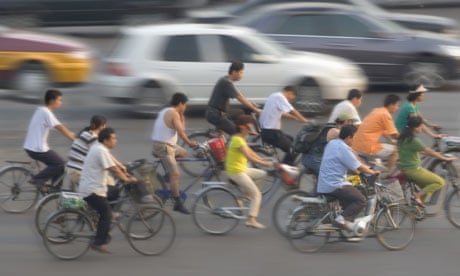After wrestling for years with Beijing's appalling traffic and pollution problems, city planners have come up with a distinctly old-fashioned solution: bicycles.
Municipal officials want to boost the number of cyclists by 25% during the next five-year plan, state media reported today. Twenty years ago, four out of five residents in the Chinese capital pedalled to work through one of the world's best systems of bicycle lanes. But the modern passion for cars has made two-wheeled transport so treacherous, dirty and unfashionable that barely a fifth of the population dares to use lanes that are now routinely blocked by parked cars and invaded by vehicles attempting to escape from the jams on the main roads.
Last year, China overtook the United States to become the world's biggest car market. Increasing affluence brings about a million new vehicles on to the roads every month, choking the streets with traffic and the air with smog.
The capital is among the worst affected cities. Since the 2008 Olympics, car owners have been ordered not to drive on certain days each week, but these controls have failed to ease congestion, so the authorities are considering additional measures.
According to the Xinhua news agency, the government hopes to improve the infrastructure for cyclists, including restored bicycle lanes and new rental programmes providing 50,000 bikes for hire by 2015. The authorities plan more bike parks near bus and subway stations in the expectation that half the city's residents will travel to work by public transport in five years.
Residents welcomed any improvement on the current system, which is so bad that some businessmen keep a fold-up bike in the boot of their chauffeur-driven cars so they can escape bad snarl-ups.
But despite unhappiness about driving, there was scepticism about the likelihood of a return of Beijing's bicycle culture.
"Fewer and fewer of my friends ride bicycles, but the interesting thing is they don't drive cars either," said Jiamin Zhao, an internet entrepreneur who still cycles his child to school each morning. "Some people are tired of driving. More are taking the subway or taxis."
Others questioned Beijing's willingness to prioritise cheap bicycles over expensive cars given the city's emphasis on economic development and its relatively lax car ownership regulations.
"I don't think they are serious about promoting bicycles. It's much easier to buy and own a car in Beijing than Shanghai," said Chen Ying, a language teacher who owns two cars. "When I started driving 10 years ago, it was something special because not many people had cars then, but now everyone has one and the traffic is terrible. If they really want me to use a bicycle, they should build clean and safe bicycle lanes. At the moment, the roads are dangerous and too smelly."
This is not the first time Beijing has promised to regain its reputation as the "Kingdom of Bicycles". Four years ago, the construction ministry announced that any bike lanes that had been narrowed or destroyed to make way for cars must be returned to their original glory. Civil servants were also encouraged to cycle to work or take public transport. Since then, however, the number of cars in Beijing has increased by more than 25% to pass the 4m mark, while there has been no obvious improvement in conditions for cyclists.
